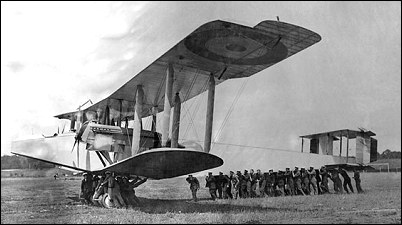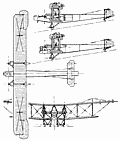 |
Handley Page H.P.11 O/1001915 |  |
| BOMBER | Virtual Aircraft Museum / United Kingdom / Handley Page |
 |
To meet an Admiralty specification of December 1914 for a large twin-engined patrol bomber, Handley Page lost little time in designing an aircraft to meet this requirement. Identified originally as the Handley Page Type O, it was later designated O/100, the figure 100 indicating its wing span in feet. Clearly, this was very much bigger than anything else that had been built by the Handley Page company; in fact, when the prototype was completed, it was the largest aeroplane that had then been built in the UK. The O/100 was of biplane configuration, with folding unequal-span constant-chord wings that had straight leading and trailing edges; these were mounted on a square-section cross-braced fuselage that terminated in a biplane tail unit. The tailskid landing gear had twin wheels on each main unit and the two 266hp Rolls-Royce Eagle II engines, in armoured nacelles, were mounted between the wings just outboard of the fuselage. Accommodation in the first prototype was in a glazed cockpit enclosure, the floor and sides of the cockpit being protected by armour plate. Flown for the first time on 18 December 1915, the O/100 was found to be inadequate in performance, and the second prototype had a revised open cockpit for a crew of two (with provision for a gunner's position forward), the cockpit armour plating and most of that incorporated in the engine nacelles was deleted, and new radiators were introduced for the water-cooled engines. When the machine was first tested in April 1916 there was a marked improvement in performance, to an extent that in early May it was flown with 20 Handley Page employees aboard to a height of just over 2135m. Formation of the first 'Handley Page Squadron', as it was then known, began in August 1916 and this unit became operational in France in late October or early November; its first recorded bombing attack was made on the night of 16-17 March 1917 against an enemy-held railway junction. In addition to their use as night bombers on the Western Front, O/100s also equipped the first bomber squadron of the RAF's Independent Force following its establishment on 5 June 1918. D.Donald "The Encyclopedia of World Aircraft", 1997
|  COMPANY PROFILE | ||||||||||||||||||||||||||||||||||||||||||||||||
 |

|

